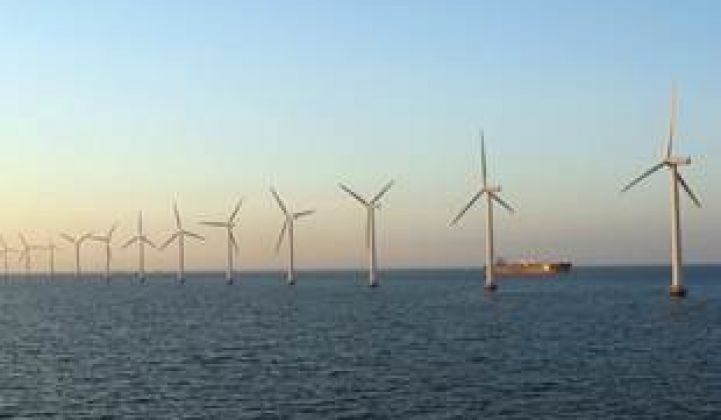Courts have once again affirmed the right of the Cape Wind offshore wind project to proceed. But another court battle is coming for the project's developer, which has been locked in the struggle to build America's first offshore wind farm for more than a decade.
In the seventeenth legal victory for Cape Wind, U.S. District Court Judge Reggie Walton ruled against four lawsuits that challenged a lease granted by the U.S. Department of the Interior.
Judge Walton rejected claims made by Cape Wind opponents about the project’s safety, location, technology, and potential historic and wildlife habitat impacts. He also affirmed the validity of the project's environmental impact statement and biological findings, but ordered federal agencies to clarify filings on right whales and migratory birds.
The lawsuits were brought by the Alliance to Protect Nantucket Sound and associated groups. The Alliance is funded in part by oil and gas billionaire and Alliance board member William Koch, according to Koch himself. His intention from the time of his initial involvement in 2002 has been to “delay, delay, delay” the building of Cape Wind’s turbines -- in large part “because [he] didn’t want to look at them.”
“The opposition is not going away,” said Alliance President/CEO Audra Parker in response to Judge Walton’s decision.
Parker says her opposition is based on Cape Wind’s environmental and economic impacts. Nantucket Sound is “a profit-maximizing site,” she said, and Cape Wind’s developer rejected suggested alternatives. “I fail to see any economic benefit,” Parker said, adding that the project’s contracted price of $0.187 per kilowatt-hour, plus the 3.5 percent annual escalator and utility charges, makes it “three times” the price of available land-based wind.
Briefs supporting Cape Wind came from the Natural Resources Defense Council, the Conservation Law Foundation of New England, and the Massachusetts Audubon Society.
A unanimous Massachusetts Supreme Court 2011 ruling found that the National Grid power purchase agreement price, which applies to 50 percent of Cape Wind’s generation, was reasonable. The estimated $2.6 billion development subsequently added a PPA for another 27.5 percent of its generation with NSTAR, Massachusetts’ other dominant utility, at the same price.
The 468-megawatt installation is the first U.S. offshore wind project to be fully permitted, to have been issued a commercial lease by the DOI, and to have received DOI approval for construction and operations.
Meanwhile, Deepwater Wind’s six-turbine pilot project, initiated after Cape Wind, is nearing the beginning of construction in Rhode Island. Leases for large projects have been granted off the Massachusetts-Rhode Island coast to Deepwater Wind and off the Virginia coast to Dominion Resources. Obama administration initiatives are providing financing and streamlining permitting in order to drive development in the Atlantic, Pacific, the Gulf of Mexico, and the Great Lakes.
Cape Wind is now in its financing phase, according to developer Jim Gordon. There is already $600 million in backing from EKF, the Danish export credit agency, as well as an undisclosed commitment from Bank of Tokyo-Mitsubishi. There are also commitments of $200 million from the Danish Pension Fund and $100 million from Siemens AG, which will furnish 130 3.6-megawatt turbines and the turbine towers.
Gordon, who began his career in natural-gas plant development, has also invested over $70 million of his own money since 2002.
The newest legal victory “clears the way for completing the financing,” and new announcements are imminent, according to Gordon. He expects full financing to be completed during the second half of 2014.
But Parker said the recent legal decision alluded to “apparent pressure” being exerted by the Department of the Interior regarding findings from the U.S. Fish and Wildlife Service about avian impacts, as well as referring to mistakes made by the National Marine Fisheries Service regarding right whale habitat concerns. She expects further delays for Cape Wind as those agencies work to rectify these shortcomings.
All but two of Judge Walton’s 31 rulings were in Cape Wind’s favor, according to Mark Rodgers, communications director for the Cape Wind project. “The other two [rulings pertained to] narrow, technical, administrative matters that will not impact financing or delay construction,” he said.
The last remaining legal battle that Cape Wind now faces is about the price approved by Massachusetts regulators for the NSTAR PPA.
The filing, made by Parker’s Alliance in U.S. District Court, alleges that the PPA was imposed on NSTAR by regulators. The filing also claims that the PPA places an unfair burden on Massachusetts ratepayers and violates the Commerce Clause by discriminating against out-of-state renewables.
"According to NSTAR's own estimates, the unconstitutional NSTAR-Cape Wind contract will increase the electricity bills of NSTAR customers by nearly $1 billion over the life of the contract," claims the Alliance lawsuit.
However, Mark Rodgers believes that the “lawsuit will be dismissed."
Project developer Gordon claims that Cape Wind’s price is competitive when all of the environmental, health and economic costs of fossil fuels are taken into account. “In the last two months, the price of electricity from Cape Wind would have been cheaper than grid electricity because the price of natural gas has skyrocketed,” he said, noting that NSTAR utility bills were up 10 percent in January.
“All the major construction contracts are signed,” Gordon added. “Cape Wind will go into construction by 2015.”
Gordon previously promised construction in 2013, and once again in 2014. However, skeptical observers contend that the Alliance and other obstructionist groups have backed seventeen lawsuits -- and can back seventeen more.
“[Koch] may not run out of money, but he is running out of courtrooms,” Gordon answered.
“No,” Parker replied when asked whether this would be her group’s last legal challenge. “We are evaluating appeals.”



